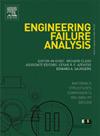Analysis of erosion morphology characteristics and mechanism of carbon brick in blast furnace hearth
IF 4.4
2区 工程技术
Q1 ENGINEERING, MECHANICAL
引用次数: 0
Abstract
The macro and micro morphology, phase, and chemical composition of carbon bricks in a large blast furnace (BF) hearth after service were analyzed. The results show that the blast furnace hearth presents “elephant foot” erosion as a whole, the ceramic pad at the bottom of the BF is completely eroded, and the erosion in the taphole area is the most serious. The erosion of carbon bricks above the taphole is mainly affected by the harmful element zinc. The erosion at the taphole is mainly caused by zinc erosion, potassium erosion, and slag-iron alternating erosion. The “elephant foot” erosion morphology is mainly caused by the circumferential flow of molten iron. The erosion morphology of the BF bottom is mainly affected by the gas blowby, resulting in the uplift of the foundation of BF and the crushing of the ceramic pad. The serious erosion of the hearth taphole area of the BF is mainly affected by the flow of molten iron. The essence of carbon brick erosion by molten iron is that carbon atoms are separated from the carbon brick, enter the interstitial position of iron atoms, and may form a solid solution.
求助全文
约1分钟内获得全文
求助全文
来源期刊

Engineering Failure Analysis
工程技术-材料科学:表征与测试
CiteScore
7.70
自引率
20.00%
发文量
956
审稿时长
47 days
期刊介绍:
Engineering Failure Analysis publishes research papers describing the analysis of engineering failures and related studies.
Papers relating to the structure, properties and behaviour of engineering materials are encouraged, particularly those which also involve the detailed application of materials parameters to problems in engineering structures, components and design. In addition to the area of materials engineering, the interacting fields of mechanical, manufacturing, aeronautical, civil, chemical, corrosion and design engineering are considered relevant. Activity should be directed at analysing engineering failures and carrying out research to help reduce the incidences of failures and to extend the operating horizons of engineering materials.
Emphasis is placed on the mechanical properties of materials and their behaviour when influenced by structure, process and environment. Metallic, polymeric, ceramic and natural materials are all included and the application of these materials to real engineering situations should be emphasised. The use of a case-study based approach is also encouraged.
Engineering Failure Analysis provides essential reference material and critical feedback into the design process thereby contributing to the prevention of engineering failures in the future. All submissions will be subject to peer review from leading experts in the field.
 求助内容:
求助内容: 应助结果提醒方式:
应助结果提醒方式:


